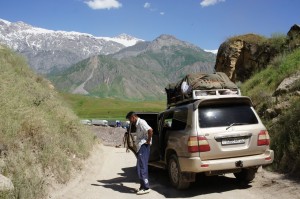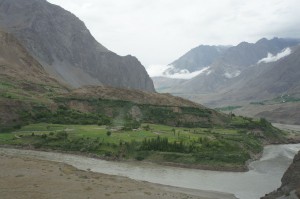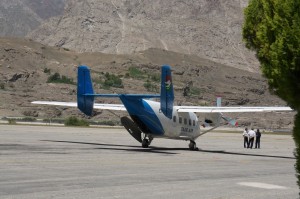Search Results for Tag: highway
On a highway to hell in Tajikistan
 Our reporter Mareike Aden took the famous Pamir Highway in Tajikistan to a remote region near the Afghan border to shoot a film about a reforestation project. The ride turned out to be long and extremely bumpy, for more reasons than one. Read her blog post to get the story.
Our reporter Mareike Aden took the famous Pamir Highway in Tajikistan to a remote region near the Afghan border to shoot a film about a reforestation project. The ride turned out to be long and extremely bumpy, for more reasons than one. Read her blog post to get the story.
We‘ve been waiting for almost two hours in the heat in front of the damaged bridge and no one knows how long it will take. Behind us and on the other side of the river, the line of SUVs (sports utility vehicles) is growing longer. Several workers are welding slabs and nailing together wooden plankts. Then suddenly our driver jumps back into the car. “Let‘s go,” he says and drives past everyone who‘s waiting in front of us. The bridge sways and rattles but holds. “The others were scared and wanted to see if it collapses,” he says and laughs.
We continue on our way after the unplanned break. We‘re on the Pamir highway that winds its way through the mountains of Tajikistan in Central Asia at an altitude of a few thousand meters. The locals call the highway simply”The Street.” It runs from the Tajik capital Dushanbe and covers a stretch of around 1,200 kilometers through the mountains till the city of Osh in Kyrgyzstan. A large part of the highway, which involves hours of driving, stretches along the Afghan border.
Our destination lies around mid-way on the highway. Khorog is the provincial capital of the mountainous Tajik region of Gorno-Badakhshan on the border to Afghanistan. There, we want to shoot a report about a German-Tajik reforestation project.
 “Around 15 hours,” is what our driver said when we left from Dushanbe in the morning. Now, it‘s late afternoon and it doesn‘t look like we‘ll be arriving anytime before midnight.
“Around 15 hours,” is what our driver said when we left from Dushanbe in the morning. Now, it‘s late afternoon and it doesn‘t look like we‘ll be arriving anytime before midnight.
By now, I wish I‘d never got to know “the Street.” The battered asphalt stretch is long over. Now we‘re bouncing over an unpaved dirt track along a slope. Our SUV rattles and shakes as we go up and down the narrow bumpy track that snakes around the mountains. When there‘s oncoming traffic, there‘s only one thing that helps – closing your eyes. But you get used to it. Just as you get used to bumping your head against the roof and gripping the door handle to brace yourself for the jolts.
At least the scenery on the other shore of the Pjandsh river distracts me – that‘s where Afghanistan lies and it‘s so close that we can see people in front of their small mud huts, children playing or colorful carpets laid to dry on the shore by the women.
To get into Khorog, home to 20,000 people, that lies on the Afghan border is not easy. Either you can take “the Street” or the allegedly most dangerous flight route in the world – thorough the Pamir mountains. It‘s said that during the Soviet era, pilots got paid an extra “risk bonus” for flying there.
Until today, small propeller-driven planes operated by Tajik Air fly to the region, but only on days when there are no clouds in the sky. We opted for a car because we really wanted to arrive there – whatever that means.
But I swear to myself that I will take a plane back after we arrive in Khorog at night after a 16-hour drive. Even our local driver who was in such a good mood to start with turned ever more silent towards the end. And the next day, my camerman Yurij admitted to me that he had secretly made emergency plans in case we‘d had an accident.
Three days later, we awere finished with our film shoot and in possession of two hotly coveted tickets for the small plane back to Dushanbe. But then – clouds appeared on the horizon. We had no choice but to get back into the car and back on the Pamir Highway.
But this time, all the bridges were intact, the rivers that our SUV had to drive through were not flooded – and after just 12 hours, we arrived in Dushanbe. “The Street” no longer seemed terrifying to us, well almost.





Feedback